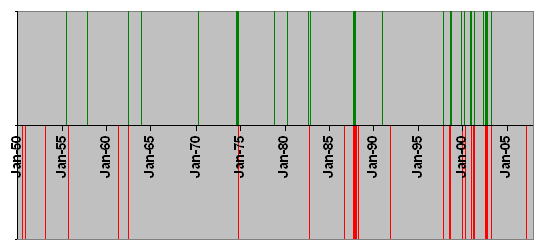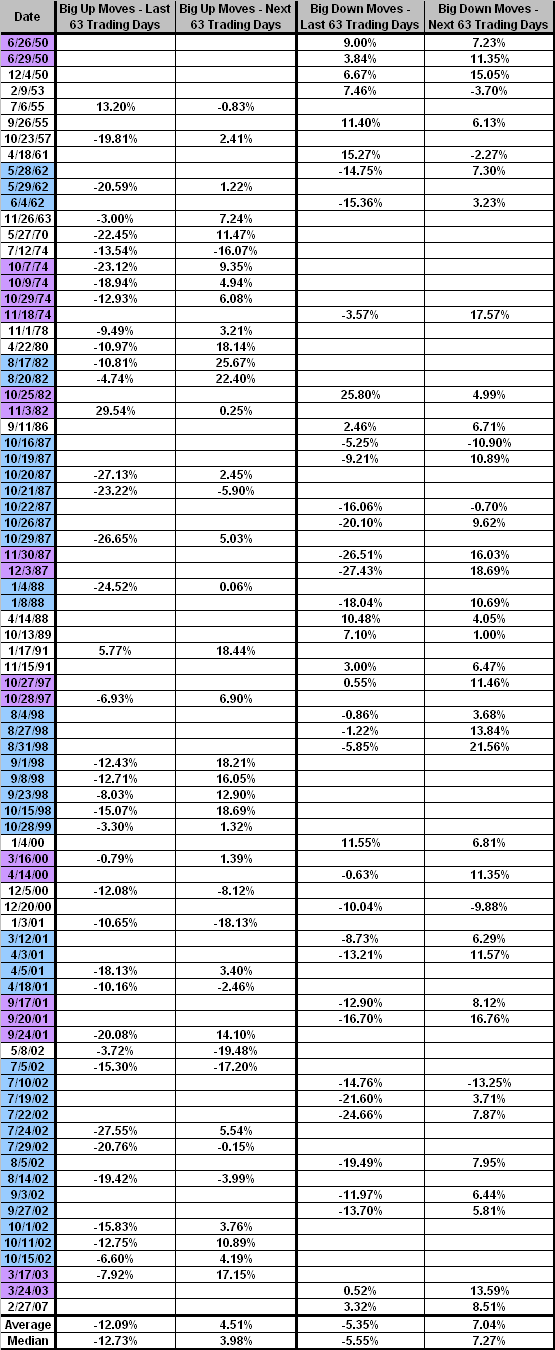A reader asked:”Do big up days tend to occur during down trends as counter-move rallies (meaning that big down days and big up days tend to cluster during downtrends)?” To check for clustering, we compare the dates of big up and down days for U.S. stock market averages. To check whether these dates tend to occur during downtrends, we examine returns during the 63 trading days before and the 63 trading days after these dates. Using daily returns for the Dow Jones Industrial Average (DJIA) during October 1928 through November 2007 and the S&P 500 index during January 1950 through November 2007, we find that:
For the DJIA sample, about three quarters of all the biggest up and down days occur during 1929-1933, potentially obscuring their “modern” meaning. We therefore rely on the S&P 500 index sample, for which we identify the 40 biggest up days (daily return > 3.50%) and the 40 biggest down days (daily return < -3.09%). The following chart identifies these dates, with big up (down) days denoted by green (red) lines above (below) the axis. Visual inspection suggests some clustering.
For a closer look, we examine the detailed data.

The following table lists in calendar order the 40 biggest up days and the 40 biggest down days for the S&P 500 index during January 1950 through November 2007. It also shows, as indications of market trends, the returns of the overall market during the 63 trading days (three months) before and after each big day (neither including the big day itself). Colored shading indicates consecutive big moves that fall within one month of each other, with 58 of 80 dates falling within clusters thusly defined. However, there is no particular pattern (such as down-up-down) or number of big days in a cluster.
The average return of the S&P 500 index in the three months before (after) big up days is -12.1% (+4.5%). Median values are close to the averages, so outliers do not dominate. The market is higher three months after big up days 75% of the time. Note that many of the three-month intervals in the sample overlap, thereby overweighting data within clusters. Winnowing such that all events are completely independent with respect to the last and next three months leaves only 15 big up days, with an average return for the index in the three months before (after) of -8.7% (+4.2%).
The average return of the S&P 500 index in the three months before (after) big down days is -5.4% (+7.0%). Again, median values are close to the averages, so outliers do not dominate. The market is higher three months after big down days 85% of the time. Winnowing such that all events are completely independent with respect to the last and next three months leaves only 17 big down days, with the average return for the index in the three months before (after) of +2.0% (+5.1%).
The average return for the S&P 500 index over a three-month period since 1950 is 2.2%, with a 65% probability of being higher. The above results therefore weakly support the conventional wisdom that high volatility, especially upside volatility, tends to coincide with market bottoms. They do not support a hypothesis that high volatility tends to be embedded within market down trends. However, the number of independent events is small.

In summary, big up and down days appear to have some tendency to cluster, with such volatility clusters associated more with market bottoms than with continuing downtrends.